Intel Xeon Bronze 3026R Benchmarks
For this exercise, we are using our legacy Linux-Bench scripts which help us see cross-platform “least common denominator” results we have been using for years as well as several results from our updated Linux-Bench2 scripts. Starting with our 2nd Generation Intel Xeon Scalable benchmarks, we are adding a number of our workload testing features to the mix as the next evolution of our platform.
At this point, our benchmarking sessions take days to run and we are generating well over a thousand data points. We are also running workloads for software companies that want to see how their software works on the latest hardware. As a result, this is a small sample of the data we are collecting and can share publicly. Our position is always that we are happy to provide some free data but we also have services to let companies run their own workloads in our lab, such as with our DemoEval service. What we do provide is an extremely controlled environment where we know every step is exactly the same and each run is done in a real-world data center, not a test bench.
We are going to show off a few results, and highlight a number of interesting data points in this article.
Python Linux 4.4.2 Kernel Compile Benchmark
This is one of the most requested benchmarks for STH over the past few years. The task was simple, we have a standard configuration file, the Linux 4.4.2 kernel from kernel.org, and make the standard auto-generated configuration utilizing every thread in the system. We are expressing results in terms of compiles per hour to make the results easier to read:
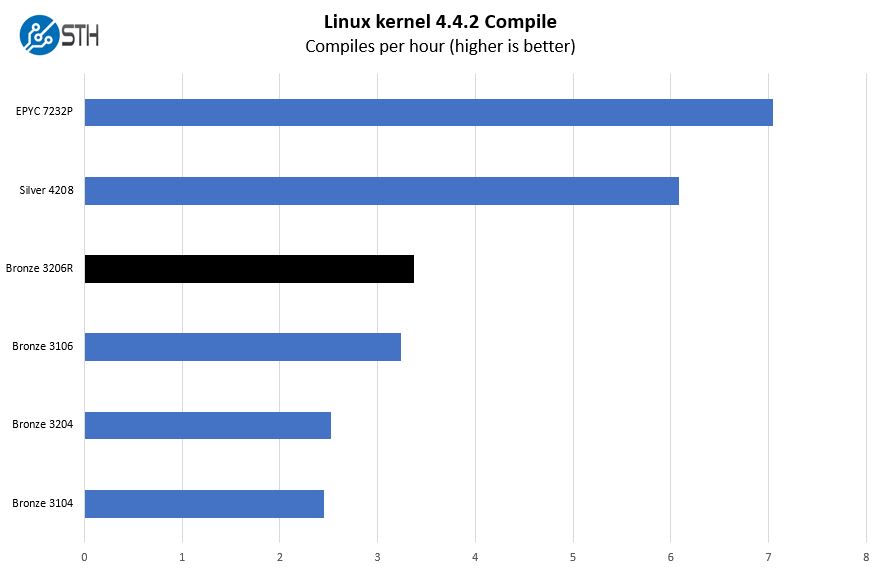
Here we put what is perhaps the universe of alternatives to the Xeon Bronze 3206R. One may consider the Silver 4210R and EPYC 7252 as alternatives, but those are a bit higher-end. We are going to focus more on the in-socket comparisons around this $300 or so price point.
c-ray 1.1 Performance
We have been using c-ray for our performance testing for years now. It is a ray tracing benchmark that is extremely popular to show differences in processors under multi-threaded workloads. We are going to use our 8K results which work well at this end of the performance spectrum.
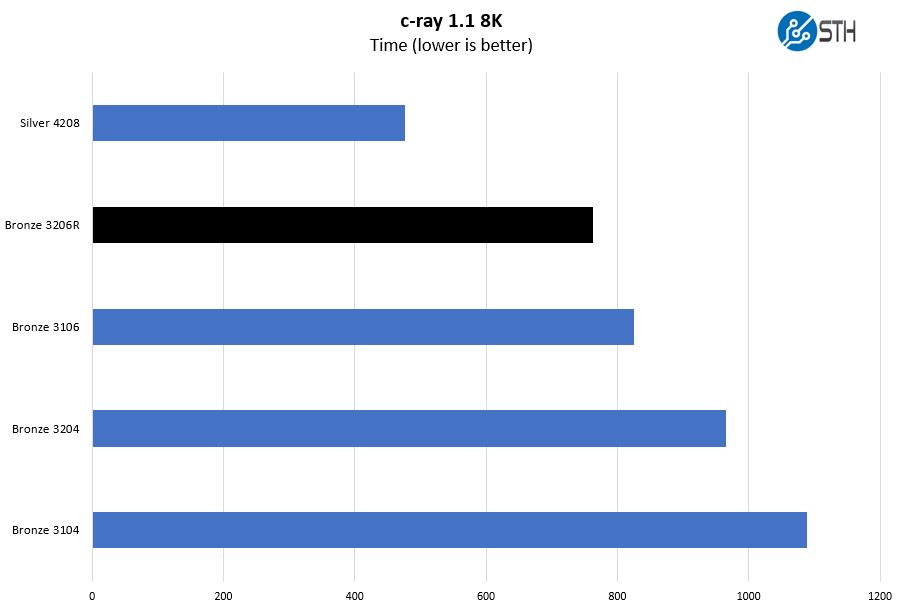
In the c-ray 8K test we see some nice generational improvement. If we want 8 cores and more performance the Intel Xeon Silver 4208 or higher is a better bet.
7-zip Compression Performance
7-zip is a widely used compression/ decompression program that works cross-platform. We started using the program during our early days with Windows testing. It is now part of Linux-Bench.
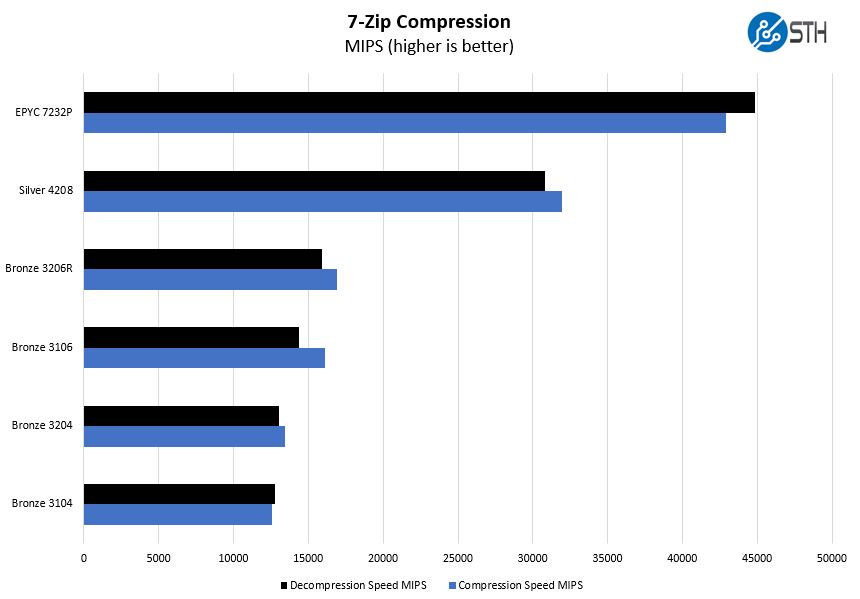
On the compression and decompression side, we just wanted to show just how large the delta is between the Bronze 3206R and AMD EPYC 7232P in terms of performance. Getting that performance costs an extra $130-150 just for the CPU. AMD is not directly competing at this price/ performance level even on P-series single-socket only parts.
NAMD Performance
NAMD is a molecular modeling benchmark developed by the Theoretical and Computational Biophysics Group in the Beckman Institute for Advanced Science and Technology at the University of Illinois at Urbana-Champaign. More information on the benchmark can be found here. With GROMACS we have been working hard to support AVX-512 and AVX2 architectures. Here are the comparison results for the legacy data set:
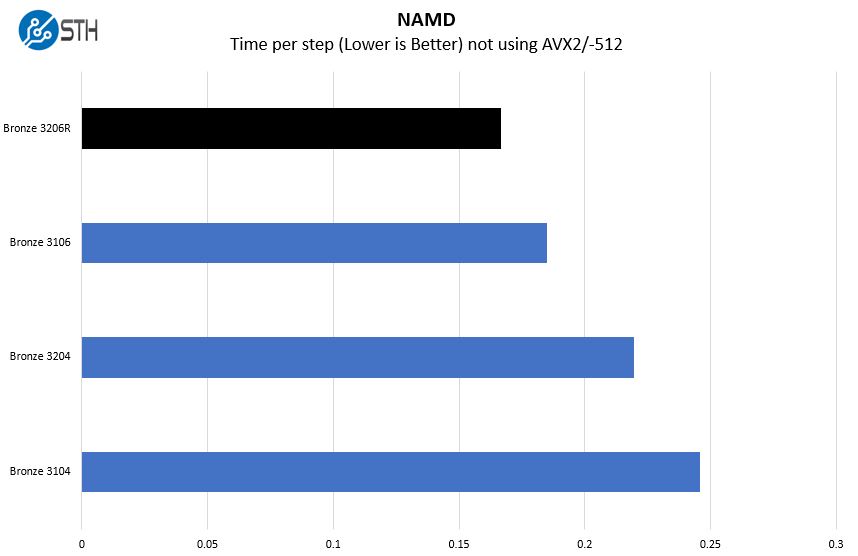
One will notice that many of the generational improvements from the Intel Xeon Bronze 3106 to the Bronze 3206R mirror what we saw with the Bronze 3104 to Bronze 3204. There was a similar clock speed bump.
Sysbench CPU test
Sysbench is another one of those widely used Linux benchmarks. We specifically are using the CPU test, not the OLTP test that we use for some storage testing.
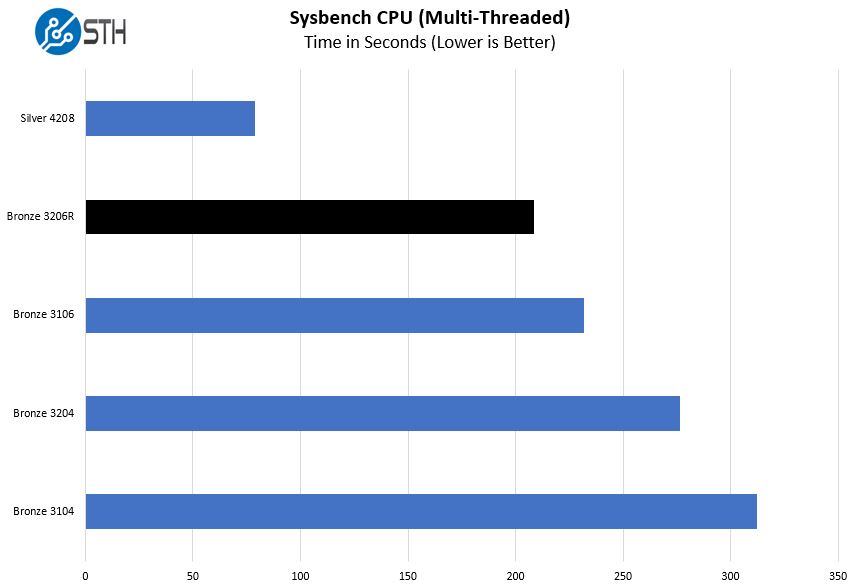
Here are the single-threaded results sorted by the same order as the multi-threaded results.
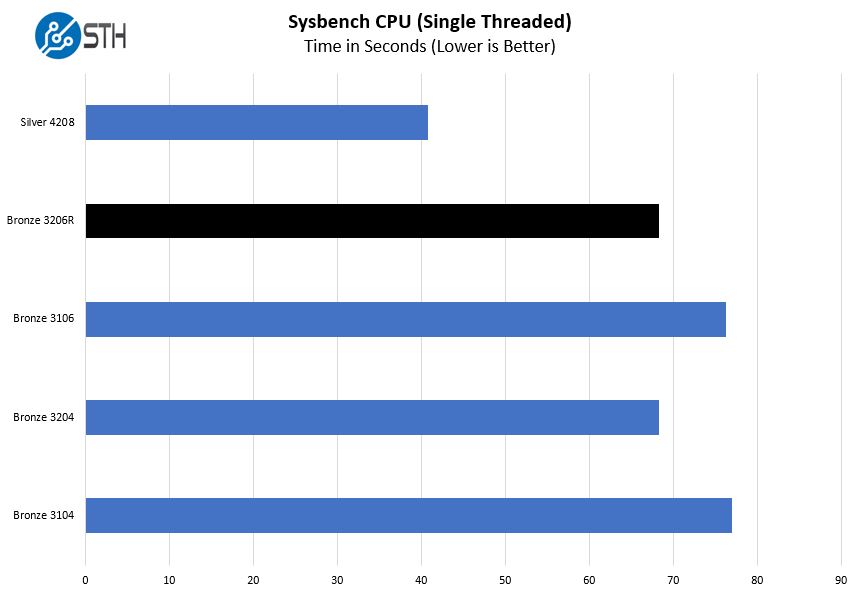
From this, we can see the impact of Turbo Boost on low core count parts as well as Hyper-Threading. The Xeon Silver 4208 is an 8 core part with those two features enabled that the Bronze 3206R does not have.
We can also see in the single-thread results three clear groups. The Turbo boost (Silver 4208), 1.9GHz (Bronze 3204 and 3206R), and 1.7GHz (Bronze 3104 and 3106) groups are very close here.
OpenSSL Performance
OpenSSL is widely used to secure communications between servers. This is an important protocol in many server stacks. We first look at our sign tests:
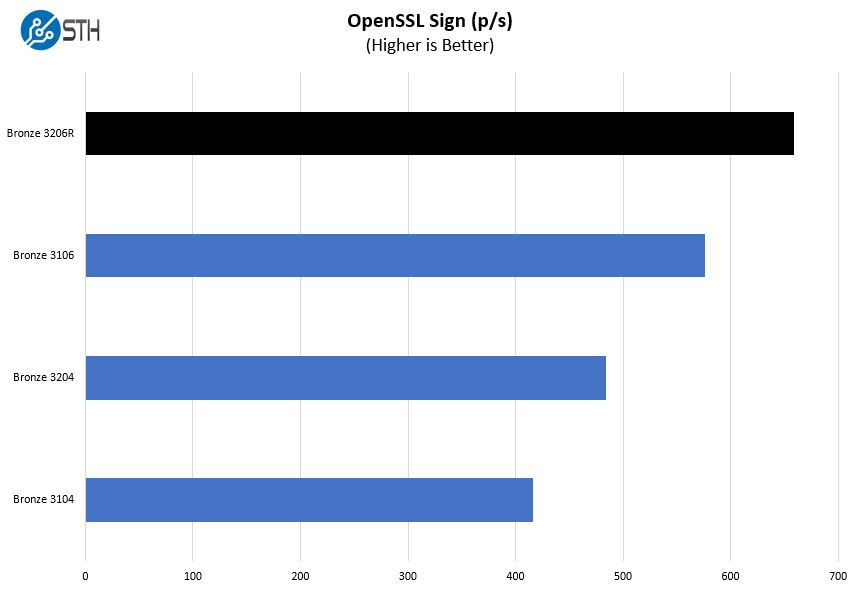
Here are the verify results:
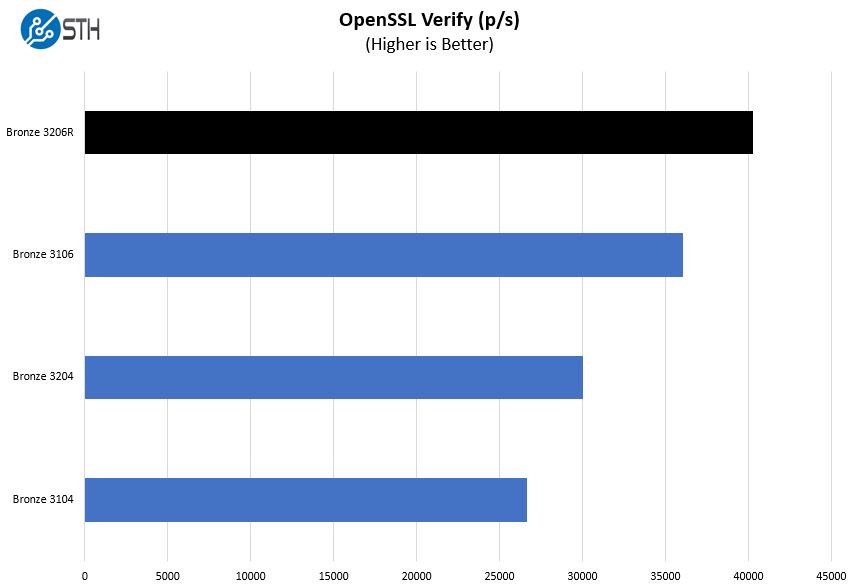
With the highest core count and clock speed combination, the Xeon Bronze 3206R is the top part in our OpenSSL testing.
UnixBench Dhrystone 2 and Whetstone Benchmarks
Some of the longest-running tests at STH are the venerable UnixBench 5.1.3 Dhrystone 2 and Whetstone results. They are certainly aging, however, we constantly get requests for them, and many angry notes when we leave them out. UnixBench is widely used so we are including it in this data set. Here are the Dhrystone 2 results:
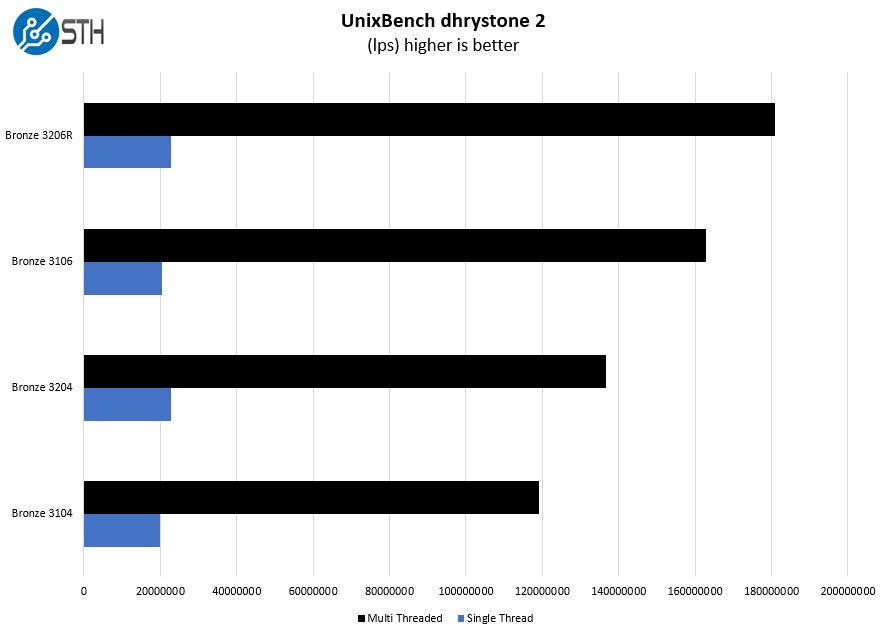
Here are the whetstone results:
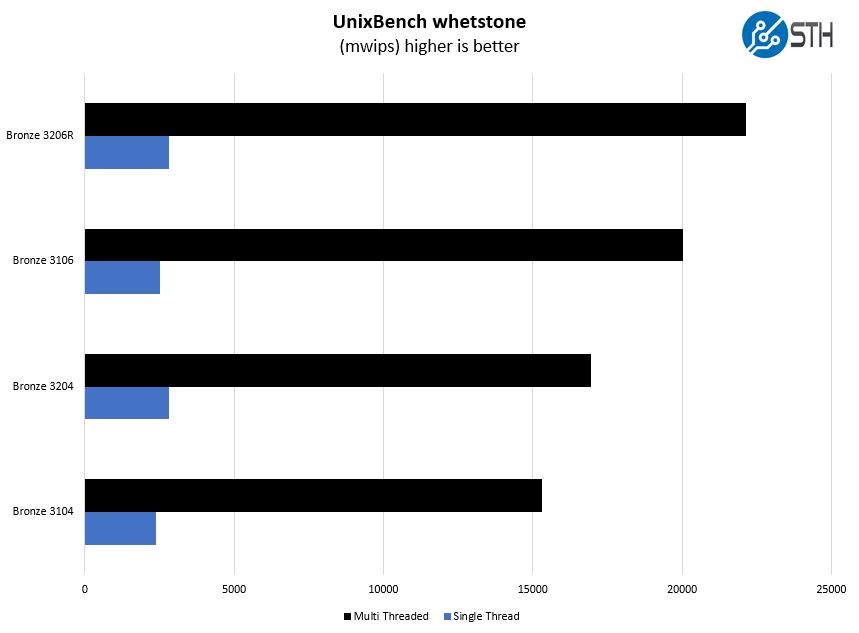
On these charts, our single thread results often get lost when we are now testing solutions with 256 threads. Still, here we can see the same 1.7Ghz and 1.9GHz groupings that define first and second-generation Xeon Bronze parts.
Chess Benchmarking
Chess is an interesting use case since it has almost unlimited complexity. Over the years, we have received a number of requests to bring back chess benchmarking. We have been profiling systems and now use the results in our mainstream reviews:
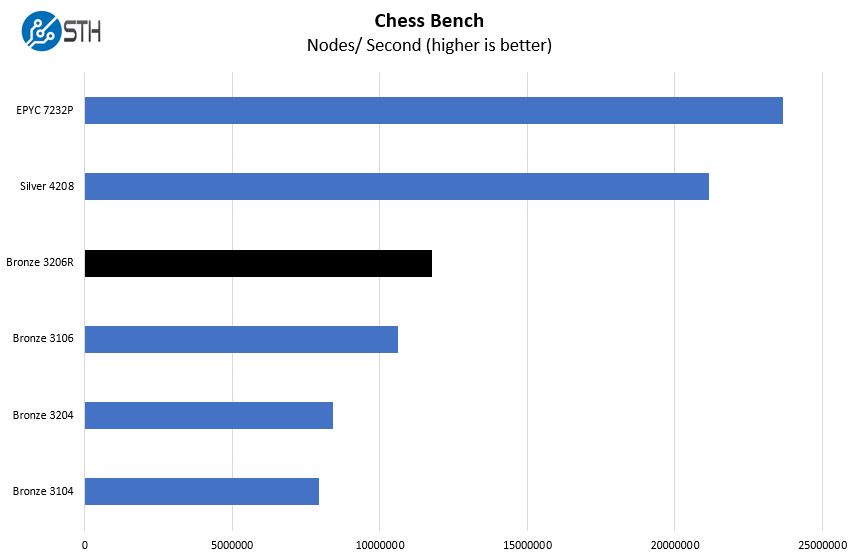
Ending with a bit of perspective again, as great as the Xeon Bronze 3206R looks, it is far from a “performance” part. Instead, it is designed more as a cost-optimized solution. While 30-50% price jumps for CPUs in this segment to access higher-end parts, in the context of a server that can effectively be 50-100% more performance for 10-20% more cost in a low-end server.
A quick note here, we have been adding virtualization benchmarks even to recent embedded part reviews such as the AMD EPYC 3451 and AMD EPYC 3351. The Xeon Bronze 3206R was not fast enough to handle the vast majority of our KVM virtual machine testing suite due to minimum performance requirements. As a result, we are omitting results here and recommending to purchase up the stack.
Next, we are going to discuss market positioning and impact before getting to our final words.




For future articles, can you please include benchmark results from other CPUs that ServeTheHome users might use? Perhaps one or 2 each from Xeon D/E, Atom 3xxx, and Epyc 3xxx.
At this price point, the Xeon 3206r is a good base for a home virtualization server so it would be nice to be able to directly compare to other similarly priced CPUs. Thanks!
John, thanks for this review. I have a file server that needs an overhaul, and I do not want to spend more on it than I have to. This CPU or the 4208 look good. Intel’s product stack is mind numbingly complex and talking to a sales rep about Intel always leaves me feeling like I’m being taken advantage of. It is nice to see some 3rd party coverage of the more pedestrian chips.
Should’ve compared it to a ryzen then. Sure, no registered ddr, but all the rest is still in place. 24 available pcie Lanes, base price of around $100, boost clock of twice the bronze CPU.. not to mention power envelope of 35W or less.
ProDigit – I think those are completely different markets which is why we are not comparing them.
It turns out, the Bronze series has a few specific niches which are what we are focused on.
If this CPU is advertised under “cost saving” category, I think it can’t compete with Ryzen CPUs if one really needs to shave BOM cost.